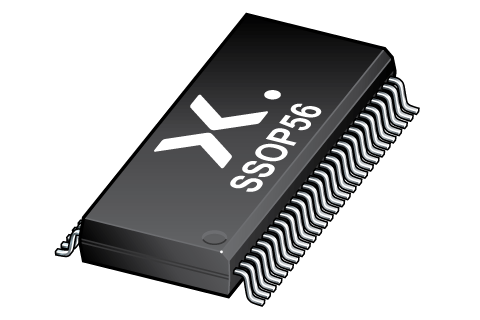
Register once, drag and drop ECAD models into your CAD tool and speed up your design.
Click here for more information74ALVT16821DL
20-bit bus interface D-type flip-flop; positive-edge trigger; 3-state
The 74ALVT16821 high-performance Bipolar Complementary Metal Oxide Semiconductor (BiCMOS) device combines low static and dynamic power dissipation with high speed and high output drive. It is designed for VCC operation at 2.5 V or 3.3 V with I/O compatibility to 5 V.
The 74ALVT16821 has two 10-bit, edge triggered registers, with each register coupled to a 3-state output buffer. The two sections of each register are controlled independently by the clock (nCP) and output enable (nOE) control gates.
Each register is fully edge triggered. The state of each D input, one set-up time before the LOW-to-HIGH clock transition, is transferred to the corresponding flip-flops Q output.
The 3-state output buffers are designed to drive heavily loaded 3-state buses, MOS memories, or MOS microprocessors.
The active low output enable (nOE) controls all ten 3-state buffers independent of the register operation. When nOE is LOW, the data in the register appears at the outputs. When nOE is HIGH, the outputs are in high-impedance OFF-state, which means they will neither drive nor load the bus.
Features and benefits
20-bit positive-edge triggered register
5 V I/O compatible
Multiple VCC and GND pins minimize switching noise
Bus hold data inputs eliminate the need for external pull-up resistors to hold unused inputs
Live insertion and extraction permitted
Power-up reset
Power-up 3-state
Output capability: +64 mA and -32 mA
Latch-up protection:
JESD78: exceeds 500 mA
ESD protection:
MIL STD 883, method 3015: exceeds 2000 V
Machine model: exceeds 200 V
Applications
Parametrics
| Type number | Product status | Package name |
|---|---|---|
| 74ALVT16821DL | End of life | SSOP56 |
Package
All type numbers in the table below are discontinued. See the table Discontinuation information for more information.
| Type number | Orderable part number, (Ordering code (12NC)) | Status | Marking | Package | Package information | Reflow-/Wave soldering | Packing |
|---|---|---|---|---|---|---|---|
| 74ALVT16821DL | 74ALVT16821DL,112 (935210000112) |
Obsolete | ALVT16821 Standard Procedure Standard Procedure |

SSOP56 (SOT371-1) |
SOT371-1 |
SSOP-TSSOP-VSO-REFLOW
SSOP-TSSOP-VSO-WAVE |
Not available |
| 74ALVT16821DL,118 (935210000118) |
Obsolete | ALVT16821 Standard Procedure Standard Procedure | Not available | ||||
| 74ALVT16821DL,512 (935210000512) |
Obsolete | ALVT16821 Standard Procedure Standard Procedure | Not available | ||||
| 74ALVT16821DL,518 (935210000518) |
Obsolete | ALVT16821 Standard Procedure Standard Procedure | Not available |
Environmental information
All type numbers in the table below are discontinued. See the table Discontinuation information for more information.
Series
Documentation (7)
| File name | Title | Type | Date |
|---|---|---|---|
| 74ALVT16821 | 20-bit bus interface D-type flip-flop; positive-edge trigger; 3-state | Data sheet | 2018-01-23 |
| alvt16821 | alvt16821 IBIS model | IBIS model | 2013-04-07 |
| Nexperia_package_poster | Nexperia package poster | Leaflet | 2020-05-15 |
| SOT371-1 | plastic, shrink small outline package; 56 leads; 0.635 mm pitch; 18.45 mm x 7.5 mm x 2.8 mm body | Package information | 2020-04-21 |
| SSOP-TSSOP-VSO-REFLOW | Footprint for reflow soldering | Reflow soldering | 2009-10-08 |
| alvt16 | alvt16 Spice model | SPICE model | 2013-05-06 |
| SSOP-TSSOP-VSO-WAVE | Footprint for wave soldering | Wave soldering | 2009-10-08 |
Support
If you are in need of design/technical support, let us know and fill in the answer form we'll get back to you shortly.
How does it work?
The interactive datasheets are based on the Nexperia MOSFET precision electrothermal models. With our interactive datasheets you can simply specify your own conditions interactively. Start by changing the values of the conditions. You can do this by using the sliders in the condition fields. By dragging the sliders you will see how the MOSFET will perform at the new conditions set.
